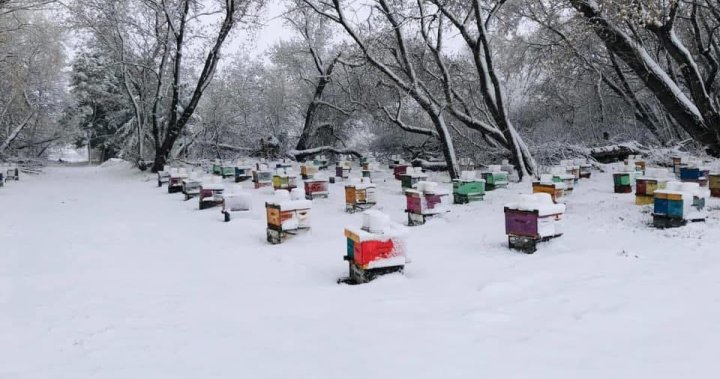The Canadian beekeeping industry is facing a crisis, with widespread colony losses threatening the livelihood of beekeepers and the stability of the agricultural sector. In 2022, almost half of all Canadian honeybee colonies perished over the winter, a devastating blow attributed to a combination of parasitic varroa mites and unfavorable weather conditions. Beekeepers are bracing themselves for potentially more losses this year, holding onto a fragile hope for a mild spring that might mitigate further devastation. The industry’s struggles underscore the interconnectedness of the ecosystem and the ripple effects of environmental challenges on food production. The precarious situation calls for urgent action to support beekeepers and ensure the health of bee populations, vital pollinators for a vast array of crops.
The primary culprit behind the massive bee die-off is the varroa mite, a parasitic arachnid that infests honeybee hives, weakening bees and spreading diseases. These mites have become increasingly resistant to available treatments, posing a formidable challenge for beekeepers. Compounding the mite problem, changing weather patterns associated with climate change are creating more favorable conditions for mite reproduction and spread. Warmer weather extends the mites’ active season, allowing them to multiply and inflict greater damage on bee colonies. This combination of parasitic infestation and climate-related stresses is pushing bee populations to the brink, forcing some beekeepers out of the industry and leaving others struggling to survive.
While beekeepers can treat their hives for mites in the spring, treatment options are limited during the winter months when bees cluster together for warmth. This leaves the colonies vulnerable to mite infestations during a critical period. Furthermore, the mites’ growing resistance to existing treatments reduces the effectiveness of these interventions, further complicating efforts to control mite populations. Beekeepers typically can recover from winter losses of up to 20% by breeding new queen bees, but losses exceeding 30% pose a severe threat to the viability of their operations. The current situation, with losses hovering around 50%, paints a grim picture for the industry’s future.
The economic ramifications of declining bee populations extend far beyond the beekeeping industry. Honeybees are essential pollinators for a significant portion of agricultural crops, contributing an estimated 15-18% to crop yields. A decline in bee populations directly translates to reduced crop production and lower profits for farmers. This ripple effect underscores the crucial role bees play in the food supply chain and the interconnectedness of ecosystems. The potential collapse of commercial beekeeping operations could have far-reaching consequences for food security and the agricultural economy.
Beekeepers, facing mounting losses and uncertain futures, are calling for government intervention to help stabilize the industry. They argue that the combined pressures of heavy losses and low crop prices make commercial beekeeping increasingly unsustainable. Without government support, they fear that more beekeepers will be forced out of business, further exacerbating the decline in bee populations and its negative impact on agricultural production. They believe that government intervention is necessary to address the root causes of the crisis, develop effective mite control strategies, and provide financial assistance to struggling beekeepers.
Despite the dire circumstances, a glimmer of hope remains. Beekeepers are known for their resilience and optimism, clinging to the possibility of favorable spring conditions that might alleviate the losses. However, even with a good year, it will take several consecutive successful seasons for beekeepers to recover from the devastating losses of recent years. The long-term survival of the beekeeping industry hinges on a multifaceted approach that addresses the challenges of mite infestations, climate change, and economic pressures. This requires collaboration between beekeepers, researchers, policymakers, and the agricultural sector to develop sustainable solutions that ensure the health and viability of bee populations for generations to come.










